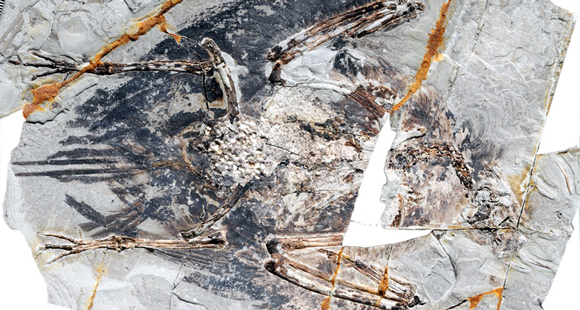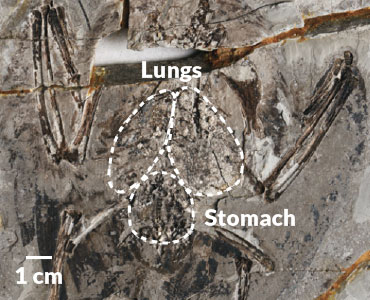Archaeorhynchus spathula – Lungs in an Ancient Bird Fossil?
Modern birds have a very efficient respiratory system. Their lungs are much more efficacious than those of mammals. However, scientists are not sure when and how this breathing system evolved. It has been suggested that the origins of the bird’s respiratory system, complete with air sacs and the ability to stop de-oxygenated air mixing with oxygenated air as it is expelled from the lungs, is one anatomical trait inherited from their dinosaur ancestors.
Writing in the academic journal the “Proceedings of the National Academy of Sciences”, a group of international scientists claim that the fossilised remains of an Early Cretaceous bird breathes new life into the evolution of the bird lungs debate.
The Main Slab Showing the Archaeorhynchus spathula Specimen

Picture credit: J. Zhang/Institute of Vertebrate Palaeontology and Palaeoanthropology (IVPP)
The Fifth Specimen of Archaeorhynchus spathula to be Described
A study of the slab and counter slab representing the fossilised remains of a prehistoric bird (Archaeorhynchus spathula), suggests that, in this remarkably complete specimen, remnants of the animal’s soft tissues including internal organs such as the lungs could have been preserved. Using scanning electron microscopy, the research team, including members of the Beijing based, Institute of Vertebrate Palaeontology and Palaeoanthropology (IVPP), identified what could be evidence of paired lungs.
The structures identified by the team suggest that Archaeorhynchus had a respiratory system capable of handling the large amount of oxygen required to sustain powered flight. Although, the conclusions drawn in the scientific paper have been questioned by several academics, if these are lungs, then it indicates that physiological adaptations in Aves came before changes in their skeleton during the evolution of anatomically modern birds.
The Scientists Identified What Could be Paired Lungs on the Counter Slab of the Fossil Specimen

Picture credit: X Wang et al (PNAS)
The Significance of this Research
Archaeorhynchus spathula is one of a number of bird genera known from the Lower Cretaceous Jiufotang Formation (China). Copious amounts of gizzard stones associated with this and the previous specimens suggest that these primitive birds were probably vegetarian. They form part of a rich prehistoric fauna known as the Jehol Biota. In total, five specimens have been described to date but this fossil, consisting of a crushed specimen represented by a slab and counter slab, is the most complete.
Numerous feathers and traces of plumage can be made out and the researchers report that Archaeorhynchus had a pintail, a feature previously not seen in Mesozoic birds. A. spathula has been classified as a basal member of the Ornithuromorpha, a group distantly related to today’s birds and one that possessed a mix of ancient and more modern anatomical features.
This fascinating fossil described as looking something like “road kill” by one observer, might have allowed palaeontologists to catch a glimpse of a stage of bird evolution where an advanced pulmonary system had evolved yet the skeleton lacked the adaptations seen in extant birds to permit efficient powered flight.
For an article published in 2007 that examined the respiration of dinosaurs: Study Indicates that Dinosaurs were Super-efficient Breathers.






Leave A Comment